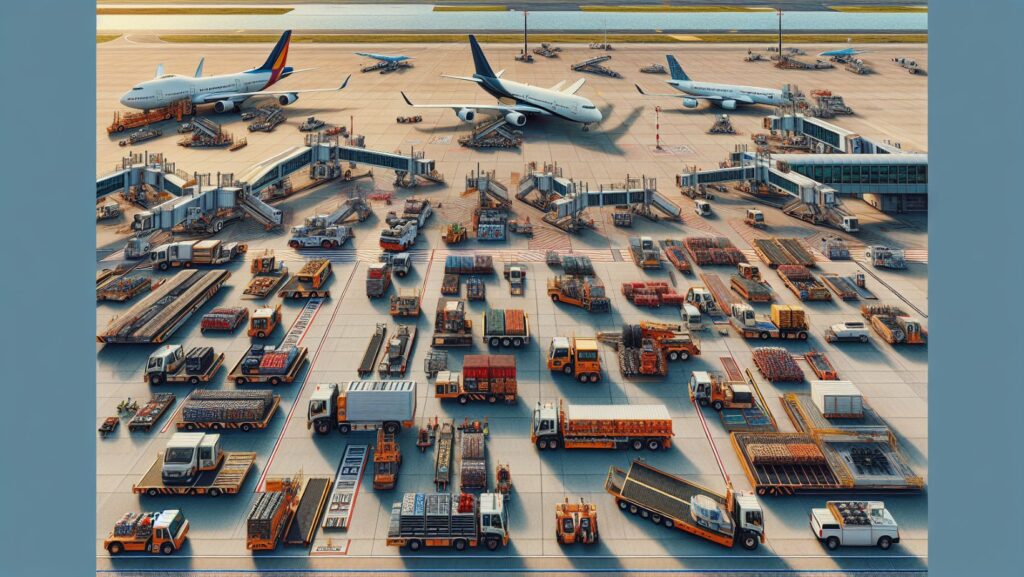Ground support equipment (GSE) is integral to airport operations. From ensuring safety to enhancing efficiency, GSE is essential for smooth functioning. Understanding its types and uses can provide valuable insights into airport logistics.
In the bustling environment of an airport, ground support equipment is indispensable. This specialized machinery ensures that aircraft and passenger services run seamlessly. As this article explores some of the various types of GSE, you’ll gain a better appreciation of its importance in aviation.
Types of ground handling equipment
Ground handling equipment is essential for the safe and efficient operation of aircraft on the ground. This category includes a wide range of machinery meant to handle baggage, cargo and passengers. For instance, baggage tractors are used to transport luggage from the terminal to the aircraft and vice versa. Without these vehicles, managing passenger luggage would be far more time-consuming and labor-intensive. These machines as well as many other elements of GSE are often provided by third-party companies like Greenwood Aerospace that sell or lease them to the airport. If you’re curious about how these machines improve efficiency, read on to explore their functionality further.
Cargo loaders are another critical piece of ground handling equipment. These machines are engineered to load and unload freight from the aircraft quickly and safely. Their ability to handle heavy loads ensures that cargo operations remain efficient and timely. Additionally, passenger stairs fall under this category, providing a means for travelers to board or deplane when jet bridges are unavailable.
Another crucial piece of ground handling equipment is the belt loader. These specialized vehicles are designed to transport baggage and cargo directly to and from the aircraft’s cargo hold. Belt loaders feature an adjustable conveyor belt that can be raised or lowered to match the height of the aircraft’s cargo door, allowing for smooth and efficient loading and unloading processes.

This equipment significantly reduces the physical strain on ground crew members and minimizes the risk of damage to luggage or cargo during handling. By streamlining the loading and unloading procedures, belt loaders contribute to faster turnaround times and improved overall airport efficiency.
Aircraft servicing equipment
Aircraft servicing equipment is vital for maintaining the operational readiness of planes between flights. This category encompasses various tools and vehicles that perform essential functions such as refueling, towing and power supply. One prominent example is the aircraft tug, which is utilized to tow airplanes to different locations within the airport. This movement is crucial for freeing up gate space and ensuring efficient airport traffic flow.
Refueling trucks play a pivotal role in keeping aircraft ready for departure. They transport fuel from storage facilities to the planes, ensuring they have enough fuel for their journey. Additionally, ground power units provide necessary electrical power to aircraft while they are parked at the gate. This allows essential systems to remain operational without draining the plane’s battery.
Passenger service equipment
Passenger service equipment improves traveler experience by facilitating smooth boarding and deplaning processes. Passenger boarding bridges, also known as jet bridges, connect the terminal directly to the aircraft door, providing a convenient path for passengers. In situations where jet bridges are not available, portable stairways offer an alternative method for boarding.
Baggage carts are another essential element of passenger service equipment. These carts transport luggage between the terminal and the aircraft efficiently. Their design minimizes manual handling, reducing the risk of damage or loss during transit. Additionally, pushback tractors are employed to position aircraft correctly before takeoff, ensuring they start their journey smoothly.
Safety and security equipment
The safety and security of both passengers and staff are paramount in airport operations.

Firefighting vehicles equipped with advanced technology stand ready to respond to any emergencies on the tarmac. These vehicles carry specialized foam agents that can extinguish fires quickly, minimizing potential damage.
Towbars are used to connect ground tugs with aircraft securely during towing operations. They ensure safe movement without risking damage to either party involved. Moreover, runway sweepers maintain clean surfaces by removing debris that could pose hazards during takeoff or landing.
Ground support equipment plays an indispensable role in aviation operations. By understanding its various types and functions, you gain insight into how airports maintain efficiency and safety daily.



